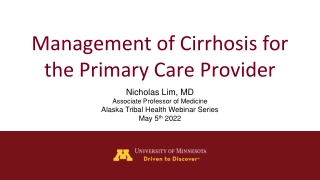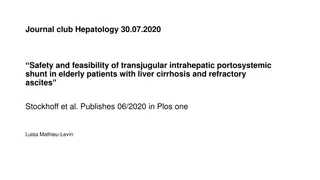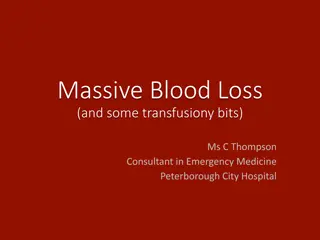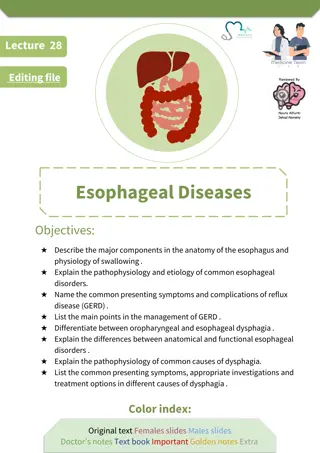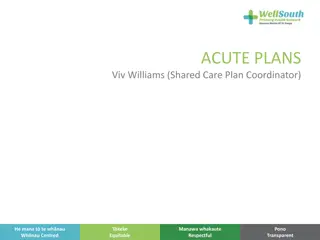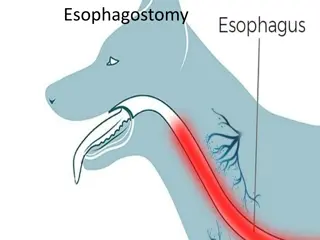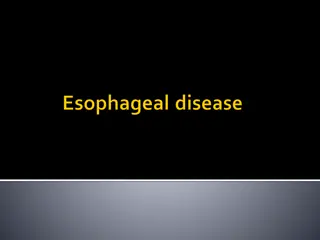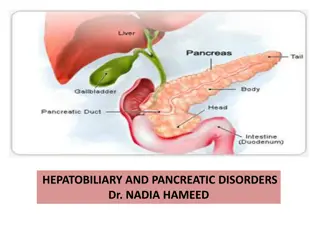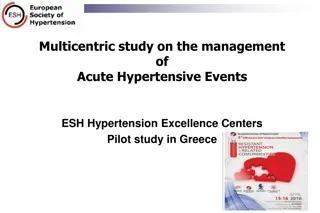Case Study: Management of Acute Esophageal Varices Bleed in a Patient with Cirrhosis
John Adams, a 55-year-old male with a history of alcoholism and cirrhosis, was admitted to the ICU with acute esophageal varices bleed. Despite abstaining from alcohol and active participation in Alcoholics Anonymous, he developed complications requiring immediate medical attention. The case involves a detailed assessment, lab results, and physician orders for management. The nurse must follow hospital protocols for blood product transfusion, administer octreotide, and monitor the patient's response closely.
Download Presentation

Please find below an Image/Link to download the presentation.
The content on the website is provided AS IS for your information and personal use only. It may not be sold, licensed, or shared on other websites without obtaining consent from the author.If you encounter any issues during the download, it is possible that the publisher has removed the file from their server.
You are allowed to download the files provided on this website for personal or commercial use, subject to the condition that they are used lawfully. All files are the property of their respective owners.
The content on the website is provided AS IS for your information and personal use only. It may not be sold, licensed, or shared on other websites without obtaining consent from the author.
E N D
Presentation Transcript
Chapter 49 Case Studies
John Adams 55 year old male
Background Admitted to the intensive care unit with the diagnosis of acute esophageal varices bleed. Long-standing history of alcoholism and cirrhosis of the liver. Six months ago, the patient received an EGD, which diagnosed the esophageal varices. The patient has quit drinking alcohol for the past 6 months and has been active in Alcoholics Anonymous.
PMHX History of coronary artery disease and angina. The patient has been taking nadolol (Corgard) and isosorbide (Isordil).
Assessment 99; 110; 26; 88/50 Placed on 2 liters oxygen
Labs H & H= 6 & 12 Platelets= 75 PT & PTT, & LFTs are elevated BUN & creatinine are also elevated
Scenario Pt comes to you with an NG that was placed in the ED Connected to low wall suction SC triple lumen with NS at 100 Received vitamin K in the ED
Orders Octreotide (Sandostatin) 5-mcg bolus followed with continuous infusion 500 mcg in 250 mL D5NS at 25 mcg/hr. Type and cross of 6 units of PRBCs STAT and transfuse 2 units of PRBCs over 2 hours each Administer furosemide (Lasix) 20 mg IVP in between each unit. Repeat CBC 1 hour after the transfusion is completed
Question In what order should the nurse institute the physician orders that are listed above?
Answer First Follow the hospital policy and procedure and obtain a signed written consent for transfusion of blood products. Obtain type and cross match for 6 units PRBCs Provide the 5-mcg bolus of octreotide, which is 2.5 mL administered IVP over 3 minutes. 500 mcg/250 mL = 2 mcg/mL 5 mcg = 2 mcg mL 1 mL Start infusion of octreotide at 25 mcg/hr = 500 mcg, 250 mL = 12.5 mL/hr is entered into the infusion pump.
Answer Second Transfuse the first unit of PRBCs over 2 hours as soon as it arrives. Observe for signs and symptoms of transfusion reaction. Once the first unit is 15 minutes from being complete, call for the second unit. Once the first unit is complete, administer the furosemide 20 mg IVP over 2 minutes. Monitor intake and output closely. Monitor electrolytes closely because furosemide may lead to hypokalemia
Answer Third One hour after the transfusion of the 2 units of PRBCs are completed, the nurse may obtain a CBC specimen from the triple lumen catheter per policy and procedure and send it to the lab for analysis
Question You observe the nasogastric secretions and, upon admission to the ICU, there was 200 mL of dark red-colored drainage. You continue to monitor the drainage and, as the nurse hangs the first unit of PRBCs, 200 mL of bright red bloody drainage is dumped into the collection canister. What should you do?
Answer Reassess the patient s vital signs, mental status, and oxygenation status, and call the gastroenterologist immediately and report the change in the drainage and the large amount of drainage and receive further orders.
Question The gastroenterologist orders you to increase the octreotide to 50 mcg/hr and the endoscopy nurse and the physician will be up shortly to perform a vertical band ligation (VBL). What do you need to do in preparation for this procedure?
Answer Increase the octreotide to 25 mL/hr Explain the vertical band ligation procedure to the patient Pull the bed away from the wall and remove the headboard so the physician can access the patient easily. Make sure that ample suction, an Ambu bag, and oral and tracheal suctioning materials are available. Have a defibrillator and emergency medical supplies on hand
Question What will happen during the procedure
Answer The physician will give the patient sedation and pain medication and numb the patient s throat and will have the patient swallow a lubricated endoscopic tube that the physician will use to view the varices that are bleeding. The physician will use the tools that are loaded in this special tube to slip an elastic rubber band through an overtube onto the varices that are bleeding to cause them to stop bleeding.
Question What will you tell the patient about how he will feel after the procedure?
Answer After the procedure, the throat will be sore and it may be difficult to swallow for a while, and it is common to have a short episode of chest discomfort that will quickly pass. The physician will give the patient pain medication to ease the discomfort
Carl Vinson 65 year old Caucasian male
Background Admitted today with increased shortness of breath, fatigue, and decreased level of consciousness.
PMHX Liver disease, most likely related to a long history of alcohol use.
Scenario Upon arrival to the unit, he is somnolent and responds only to shouting and shaking. Upon arousal, he is only able to state his first name. His wife accompanies him to the unit, and describes that he has become increasingly restless over the last 3 days, and she is concerned for his safety. Additionally, he has not eaten or taken in any fluids in 24 hours
Question Correlate the patient s presenting clinical manifestations to hepatic encephalopathy
Answer The earliest symptoms of hepatic encephalopathy include minor mental changes and motor disturbances. Mr. Vinson has a decreased level of consciousness, and is somnolent. The restlessness may also be an indication of hepatic encephalopathy.
Question The physician orders a STAT ammonia level, along with a CBC and complete chemistry panel. The ammonia result is elevated. What is your interpretation?
Answer The largest source of ammonia is the enzymatic and bacterial digestion of dietary and blood proteins in the GI tract. Ammonia from these sources increases as a result of GI bleeding (i.e., bleeding esophageal varices, chronic GI bleeding), a high-protein diet, bacterial infection, or uremia.
Question The physician orders Mr. Vinson to receive lactulose (Cephulac) orally. What is the rationale for this medication?
Answer Lactulose is given to lower serum ammonia levels by increasing ammonia excretion in the stool. It acts this way because ammonia is maintained in an ionized state, resulting in a decrease in colon pH, reversing the normal passage of ammonia from the colon to the blood. Evacuation of the bowel decreases the ammonia absorbed from the colon. The fecal flora are changed to organisms that do not produce ammonia from urea.
Question Mrs. Vinson asks why her husband must decrease intake of protein. How will you respond to her question?
Answer The largest source of ammonia is the enzymatic and bacterial digestion of dietary and blood proteins in the GI tract. Modifying dietary protein is intended to decrease serum ammonia levels.


